
“Re-Modernologio” Phase1: Contemplationg Society Through Daily
July 23 (Sat) ~ September 19 (Mon), 2011 10:00 - 18:00 / Free
NISHIO Yoshinari
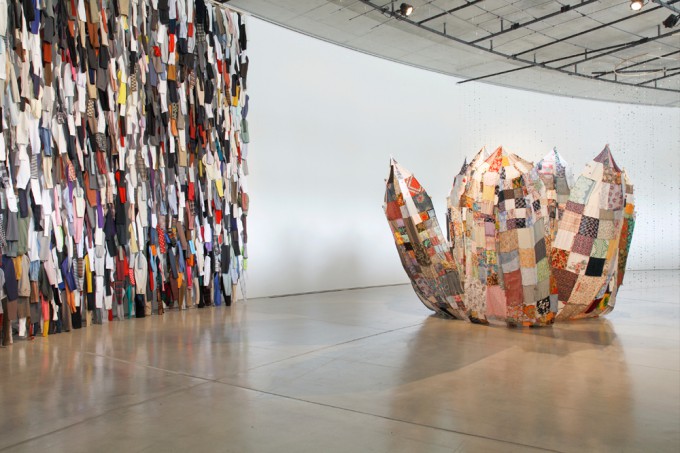
1000 Coordinates Installation view
Open the Way for Novel Living Spaces by “Clothing” as Artistic Production Activity
HATTORI Hiroyuki
A sentence in NISHIO Yoshinari’s profile describes his overall artistic activity plainly, though at first sight it seems difficult to understand; his works have consistently revolved around relationships between clothing and communication. His artistic activity dates back to his childhood when he was crazy about clothes. Beginning in elementary school he started dressing himself in a variety of elaborate styles and enjoyed seeing his friends or surrounding people reacting to his appearance. Thus he began, without realizing it at the time, creating relationships with others by putting on clothes. While growing up, however, he started to feel discomfited by the fact that no matter how eccentric his clothing, people looked at him strangely but without any actual interest in his identity, apart from his friends and acquaintances. His odd appearance interfered with his attempt to communicate freely and smoothly with others. Since then he has given himself over to creating work based on clothing as an art material, not fashion design.
He has been exploring the full scope of his creative activities under the name “Nishio Workshop,” while maintaining several footholds in Japan and abroad with those in Tokyo and Nairobi as his main bases. The name “Nishio Workshop” refers clearly to his unique approach to clothing-as-art in that it is derived from the name of his grandfather and father’s firm where they manufactured parts of sewing machines. As we know the word “workshop” means a room or building in which things are made or repaired using tools or machinery. Nishio seems to be intent on building his own production system and economic principle, regarding his artistic activity as factory production in the cottage industry.
The ”Form on Words Factory” is a case of such practice at the Higashi-Oizumi Children’s House in Nerima city, Tokyo. In this work he explores the way communication arises using “words” and “clothing” as tools. He has developed a kind of system, like in some games, which can easily be used by anyone, without his presence, and it involves making a versatile and simple rule that you can apply wherever old clothes and a few people are available. It may well remind you of “Kaekko”ⅰ by FUJI Hiroshi and “Asatte Asagao Project”ⅱ by HIBINO Katsuhiko. In Fuji’s profile you see the following sentence: “…he continues performing workshops and demonstrations all over Japan, and exploring techniques to build Operation Systems for creating a new type of activity in a community.”ⅲ It is plain that these are practices antecedent to Nishio’s. To be sure, his practices and theirs have something in common in that all of them are inclined to build systems for enhancing communication among people, but a major difference between his and theirs is that he is not aimed chiefly at developing his activity around the idea of “community.” His main purpose is to pursue a new way of looking at clothing. He attaches much importance to “clothing,” which has helped form his identity, and he has considered every project as his own opportunity to ponder over fashion.
His major art projects include “Self Select” in which he exchanges clothes with unknown pedestrians who happen to pass by him and has each full-length portrait photographed on the street in various cities across the world, and “Familial Uniform” in which he reproduces old family photos with the same family members in the same clothes at the same places. Such projects can prompt you to ponder relationships between fashion and identity. These art works evoke a laugh because there is something comical about them, although sometimes he may seem a bit pushy by asking the strangers to exchange clothes unexpectedly or by making someone put on clothes reproduced from old family photos. That may not be just because you’re reminded of somewhat tense scenes where he tries to communicate with the others, but also because of a certain oddness in his appearance. There is something strange but attractive about him with feminine bobbed hair and putting on work clothes or nightclothes as his everyday clothes. He says that he has felt embarrassed by a situation where people try to evaluate a person by his appearance, so came to choose such styles that challenge people’s stereotypes in order to prevent others from categorizing him by his appearance. His practice of exploring “relationships between clothing and communication” might originate from such a way of thinking. He tries to transform the existing value system slightly through his daily clothing choices and we may feel this can make our daily lives more creative and enjoyable.
The mention below of “1000 Coordinates,” which is his project for this exhibition, should be seen in light of the above premise. He was invited to exhibit his works during the final stage of the project inside a large exhibition hall 6 meters high, 10 meters wide and 40 meters long. For that purpose, the following strategy was chosen naturally: “Nishio Workshop Aomori Office” was set up in Aomori Contemporary Art Centre, and advertised to the public requesting volunteer staff who would work in cooperation with him and whose numbers grew by the day until he had a total of 60 volunteers. He collected 4000 pieces of old clothing from citizens around Aomori city, because this is the average number of clothes one person uses in his or her entire life, according to statistical data gathered by Nishio. Such a quantity of old clothes was collected in a month without much difficulty because every house stows old clothes away deep inside wardrobes. In light of this fact, we might consider the extremely quick growth of the consumer culture within our modern social system.
While collecting old clothes is Nishio’s favorite method for making art and he has done so in many parts of the world, he says that he has never examined in detail what the collected clothes are or look like. However this time he devised a plan to look closely at the nature of our society and our lifestyles by sorting all the collected clothes by type and by analyzing them through the lens of “Re-Modernologio.” With that in mind, he designed a basic system for such analysis, like a kind of rules in games, i.e. asking participants “to coordinate clothing from head to toe using those old clothes.” The participants freely matched trousers with shirts and so forth, selecting from a heap of 4000 old pieces of clothing, creating 1000 outfits in total, while also filling out an A4-sized analysis paper which asked them to explain each of their outfits in detail. Then Nishio put on every outfit, photographed himself as though for a portfolio with front, back and both sides, and turned the 4000 pictures into a film. The title of the whole project is “1000 Coordinates,” after the 1000 analysis papers, and included the film that was projected onto the entire wall of the exhibition hall. It took about a month to complete this operation that might have been the most meaningful part of the project in one sense. Though the action of wearing 4000 different pieces of clothing may be somewhat exhausting and masochistic, there is something humorous for the artist in this action in that he honestly obeyed his own rule of wearing every outfit and even put on slender dresses and lingerie calmly, and it seemed to have purged those old clothes of their personal memories.
In the next stage of the operation participants took the old clothes apart into pieces. Then he produced the new installation work inside the hall using those pieces based on his own interpretation of the characteristics and functions of each piece of clothing. This installation is composed of 5 pieces of three-dimensional landscape: “Buttons/ Rain” in which 8000 buttons were united by fishing net and hung from the ceiling to the floor; “Floral Prints/ Flower” which is a giant flower made up of petals in only floral prints using draping techniques; “Sleeves/ Waterfall” in which 1650 pieces of sleeves were hung from the ceiling to the floor like a gigantic waterfall; “Sweaters/ Clouds” in which unraveled woolen sweaters were arranged together around a net using twine; and “Clothes/ Strata” which is an installation using all the scraps discarded from the other pieces. An interesting point with this kind of production process is that Nishio gave very little instructions to volunteer staff, sharing only simple phrases such as “rain of buttons,” allowing each assistant a great deal of autonomy during the process, as he has done in his other projects. He does not strive for faultless accuracy of technique in his work but rather for the creation of a system that is tolerant of accidents and serendipity.
Referring to such work he talks about “using installation to display the results of analyzing collected and classified clothes, for example, the nature of the floral patterns and sleeves.”ⅳ In addition, the works were compiled from elements of his past projects, so that we might call it the complete work of his artistic activity to date. To give you some example, “1000 Coordinates” is based on “Self Select” and “Floral Prints/ Flower” on “Overall”. Every operation for producing the installation could be said to be a process of editing his past artistic activities into something novel and displaying them together.
KAWAMATA Tadashi remarks in his book that he wants to practice very ordinary things, which he names “Artless,”ⅴ while retaining a reasonable amount of freedom. Similar to this idea, Nishio’s artistic activity also involves very ordinary practices such as exchanging clothes, making patchworks and choosing what he wants to wear. He merely generates a slightly different value to what people practice in their daily lives. This value can be found in a practice that is considered valueless by the economic principles of modern capitalism, in that exchanging clothes can be interpreted as communication and making patchworks as collaborative work, from his viewpoint. He assimilates the ordinary behavior of daily life into creative activity, and such daily behavior as choosing or exchanging clothes can be transformed into a kind of production activity. The aim of this activity is to establish a kind of system for living by means of artistic production in society that encompasses the new era of fashion design and does so in a way that goes beyond mere hobby but becomes a way of life.
In the artist’s eyes, what does he see as the parameters of a daily life? He has chosen to deal with clothing as his lifelong artistic medium, not just as consumer items like in fashion, but by separating and emphasizing each function of “clothing,” such as representing individuals’ identity or sheltering them from their surrounding environment. By doing so, new values can be created and spread into our daily lives so as to establish a unique economic community. Nishio states that the next objective is to set up his own fashion label. He refers not just to the production of clothing, but also to the creation of novel and creative living spaces in which fashion design is seen as a wide-reaching artistic production activity using clothing that can include art projects, workshops or exhibitions, all under the name of “Nishio Workshop.” His attempts to provide a voice that questions the homogeneous social sense of value in the capitalistic economy, to enhance his own ability to work and to find new ways of developing a community-based economy could present an alternative option for surviving in our coming era.
References
ⅰOfficial website of FUJI Hiroshi, ‘What’s Kaekko’: http://geco.jp/kaekko/
ⅱOfficial website of Asatte Asagao Project: http://www.asatte.jp/asatteasagaoproject/
ⅲOfficial website of FUJI Hiroshi, ‘Biography’: http://www.geco.jp/biograf/fujiBio.htm
ⅳInterview with NISHIO Yoshinari in AC2 vol.13.
ⅴKAWAMATA, Tadashi. (2001). Artless. Film Art Inc., p231.
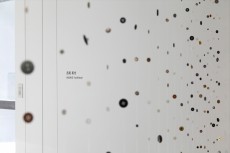
Buttons / Rain

1000 Coordinates Installation view
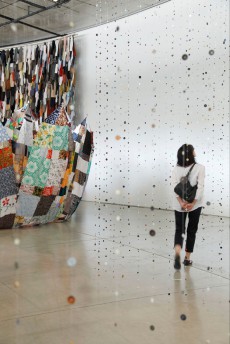
1000 Coordinates Installation view

Sleeves / Waterfall
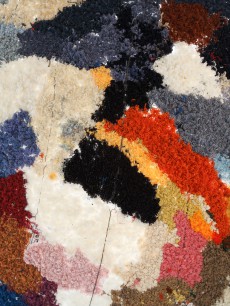
Sleeves / Waterfall
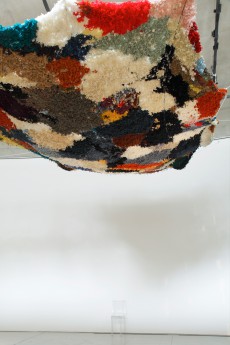
Sweaters / Cloud

Clothes / Strata

Clothes / Strata
「再考現学 / Re-Modernologio」 phase1 : 衣食住から社会をまなざす
2011年7月23日(土)~ 9月19日(月)10:00 - 18:00/無料
西尾美也
NISHIO Yoshinari

《1000 Coordinates》部分
芸術生産活動としての「装い」が拓く新たな生活圏
服部浩之
「装いの行為とコミュニケーションの関係性に介入する」という西尾美也のプロフィールに記された一言は彼の活動をよく象徴しているが、一見すると意味が掴みにくい。西尾の現在の活動の出発点は「服が好き」という子供の頃からの変わらぬ思いで、小学生の頃から趣向を凝らして衣服を纏い、それに対する友人や周囲の反応を楽むという服を身に着けることで他者との関係を築くことを既に無意識に実践していた。しかし一歩仲間内という輪を離れると、どんな奇抜な装いをしてもほとんど誰からも見向きもされず単なる派手好きで片付けられてしまうというコミュニケーションが遮断された状態になることに違和感を感じたことにより、いわゆるファッションデザインではなく、現在のような「衣服で装う」ことを基調としたアート活動に向かっていったという。
西尾はその幅広い活動を「西尾工作所(英語名 Nishio Workshop)」と名付け展開する。彼は複数の拠点を持ちながら独自のアート活動を築くことを試みており、現在は東京とナイロビをベースにしている。 「西尾工作所」という名前は、彼の祖父と父が営んでいたミシンのパーツを生産する会社の社名に由来するのだが、ある意味この命名は彼の思想をよく表明していると思われる。英語名には「作業場、工作室、工場」などを意味する"workshop"ということばが採用されており、西尾は自身の活動をある種の家内制手工業の工場に見立て、独自の生産システムと経済原理を築きあげようとしているように感じるのだ。例えば東京都練馬区の東大泉児童館を中心に展開している「ことばのかたち工房」は、「ことば」と「装い」をツールにコニュニケーションのあり方を探求するものだ。西尾は、古着があって数人の人がいればどこでも展開できる汎用性の高いシンプルなルールを構築することにより、彼がいなくても無理なくどこでも実施できる遊びのようなシステムを開発したのだ。当然これは藤浩志による「かえっこ[i]」や日比野克彦による「明後日朝顔[ii]」などを想起させる。藤のプロフィールに、「全国各地でワークショップとデモンストレーションを重ね、地域に新しいタイプの活動をつくりだすシステム型の[OS的表現]を模索する[iii]」 とあるように、これはまさに西尾が実践していることの明解な先行事例であろう。他者と関わるシステムを組み立てることでプロジェクトを行うという点では藤や日比野の活動に通じる部分はあるが、彼らと西尾が圧倒的に異なるのは、西尾は地域での活動を築くことに主眼を置くのではなく、あくまでファッションデザインの新しいあり方を探求しているという点だ。西尾にとって「衣服」という存在は非常に重要で、それは彼のアイデンティティに関わる問題であり、どのプロジェクトもファッションを思考する手法としてあるのだ。
海外で見知らぬ人に声を掛けお互いの衣服をその場で交換しポートレートを撮影する《self select》や、何十年も前に撮影された家族の記念写真を同じメンバー・場所・服装で再現する《家族の制服》などは、 ファッションとアイデンティティについて考察するプロジェクトとも言えるだろう。見知らぬ他人と唐突に服を交換することも、昔の服装を再現して着せてしまうことも、その行為だけを取り出すと強引な力技だと感じる部分はあるが、その作品にはつい笑いを誘われるコミカルさがある。現場での西尾と他者とのやりとりなど、その背後にあるちょっとした緊張感のある時間や空間が想起されるからということもあるが、もうひとつに西尾自身のキャラクターに起因する部分も大きいようだ。女性を思わせるボブカットに、作業着や寝間着として売られている衣類を普段着として読み替え着用するその姿には、なにか不思議な魅力があるのだ。外見により人の属性が判断されがちであるということに疑問を感じ、服装から自分をカテゴライズされることを避けるために、予め想定された服の役割を外したファッションを採用するようになったそうだが、これはまさに「装いの行為とコミュニケーションの関係性」を考える行動の原点となる発想と言えよう。衣服の着用というごく当たり前の行為から既存の価値判断を少しだけ転換しようとするこの試みは、日常生活をより創造的に楽しむ大きな可能性を 提示していると思われる。
その前提のうえで今回実践した『1000 coordinates』というプロジェクトについて言及していきたい。天井高6m、幅10mで奥行きが40m程ある大きな展示スペースで西尾の活動を公開するという明確な最終目標があったため、西尾工作所青森支部をACAC内に設置し、公募で市民スタッフを募り、集まった約60名と共同制作を展開するというプロジェクトの骨子が自然と形成された。西尾は統計データなどを根拠に人が一生で着用する衣類の平均的な総数を4,000着程度であると算出し、その総量の古着を青森市を中心に募集した。どこの家庭にもタンスの奥に眠る服は必ず存在し、約1ヶ月で4000着の古着はあまり苦もなく集まってしまった。この状況のみからでも、現代の社会構造が生み出した消費文化について考えさせられるものがあった。
これまでも西尾は様々な地域で古着を収集し、それを用いて作品をつくってきたが、集まる古着がどんなものか考えたことはあまりなかったと言う。今回「再考現学」という テーマのもと、集まった4000着の古着すべてを整理分類分析し、それにより現在の社会や生活像を検証していくことを考えた。そのため西尾は「古着を用い て全身コーディネイトをする」という(遊びのような)ルールを、衣服分析の基本システムとして設計した。具体的には4000着の古着の山からシャツ、T シャツ、ズボンなどを参加者が自由に組み合わせ1000のコーディネイトを完成させ、同時にそのコーディネイトひとつひとつについて詳述するA4の分析シートを記入するというものだ。コーディネイトされた衣類はすべて西尾が着用し、正面、背面、両側面の4カットを写真撮影し、計4000枚の写真をつなげ、着せ替えアニメーションを作成した。この1000枚の分析シートをアニメーション映像とともに壁面いっぱいに展開したものがプロジェクト全体のタイト ルとも共通する《1000 coordinates》となる。この行程には約1ヶ月を要し、今回のプロジェクトの大きな魅力はある種ここに集約されていると言ってよいかもしれない。 4000着の服をひたすら着用するという行為自体はやはり少々暴力的で自虐的とも思われるのだが、女性もののスリムなワンピースであろうが、下着だろうが、コーディネイトされたものを全て着用するというルールを徹底的に遵守し淡々とこなしていく姿には、古着が持つ個別の記憶などをうまい具合に脱臭する効能があるだけでなく、その行為自体に笑いを誘われるユーモアが溢れているのだ。
西尾が着用して撮影するという 儀式を終えた服は、市民スタッフの手によって解体されていく。西尾は服が元来備えている性質や機能を手がかりに、ギャラリー内に立体的な風景を生成した。 8000個のボタンを天井から床までテグスにつなげて設置するボタンの雨《Buttons/ Rain》、花柄の服のみで立体裁断による花びらをつくり構成した花柄の花《Floral prints/ Flower》、1650枚の袖を滝のように天井から床まで埋め尽くした《Sleeves/ Waterfall》、ほどいたセーターをネットに編み込んで生み出した雲《Sweaters/ Clouds》、最後に残った全ての服のパーツを積層させてつくる服の地層《Clothes/ Strata》。興味深いのは、ここでも西尾は市民スタッフと「ボタンの雨」などのことばを共有するのみで、細部はある程度それぞれのスタッフに委ねることだ。完璧な精度による工芸作品ではなく、様々な偶然を許容する仕組みとしてのプロジェクト。
これらのインスタレーションについて西尾は、「どんな花柄があったのか、どんな袖があったのかなどを収集分類して陳列するひとつの手法としてのインスタレーション[iv]」という。また、これらはこれまでの西尾の活動の集大成とも言えるように、過去のプロジェクトのうえに成立している。《self select》があったうえでの《1000 coordinates》、《overall》の経験があっての《Floral prints/ Flower》。これは過去の活動を別のかたちで編集し陳列公開する作業でもあるのだ。
川俣正は、「とりあえずそれなりの自由度もいつも持ちながら、しかし限りなく普通のこと(アートレス)をしていたいと思う。[v]」 という。西尾の活動は服を交換したり、パッチワークをしたり、あるいは着るものを選んだりと、極めて普通の行為だ。彼は人が当たり前に実践していることに少しだけ異なった価値を与える。服を着替えることをコミュニケーションとして読み替えたり、パッチワークを共同作業に変換したりと、いわゆる資本主義の経 済原理では対価が得られないと思われる行為に価値を見出す。西尾は日々の生活行為を制作活動と同化させ、服を選んだり着替えたりするその日常の営為をその まま生産活動に転化させてしまうのだ。これらの行為の総体をもって新しい時代のファッションデザイン(つまりモード)として、マイナーな個人の趣味ではなく、社会における芸術生産による生活システムを成立させようとしているのだ。
日々を生きるというのはどういうことだろうか。西尾は生涯をかけて執着できる「衣服」を、単なるファッション(=流行)として消費するのではなく、「服」が備えるアイデンティティの表象機能や身体の保護機能を、ほんの少し解体または強調することで、新たな価値を引き出し、独自の経済圏を築いていこうとしている。西尾は今後ファッションデザインをしたいという。単に 服をつくるだけではなく、西尾工作所という名称が示すとおり、アートプロジェクトやワークショップ、あるいは展覧会など、装いに関わる様々な芸術生産活動の総体をファッションデザインと定義し、独自の創造的な生活環境を構築しようと試みているのだ。資本主義経済による一様な価値観に疑問を投げかけ、独自の 職能と地域経済のあり方を模索する西尾の試みは、これからの社会を生き抜く多様な選択肢の新たな一端を提示してくれるかもしれない。
[i] 藤浩志ウェブサイト「かえっこについて」参照 http://geco.jp/kaekko/
[ii] 明後日朝顔プロジェクトウェブサイト参照 http://www.asatte.jp/asatteasagaoproject/
[iii] 藤浩志ウェブサイト「藤浩志経歴・紹介文」参照 http://www.geco.jp/biograf/fujiBio.htm
[iv] AC2 13号 西尾美也インタビュー参照
[v] 川俣正、『アートレス―マイノリティとしての現代美術』、フィルムアート社、2001年(p.231)

《Buttons / Rain》

《1000 Coordinates》全景

《1000 Coordinates》部分

《Sleeves / Waterfall》

《Sweaters / Clouds》

《Sweaters / Clouds》

《Clothes / Strata》

《Clothes / Strata》
